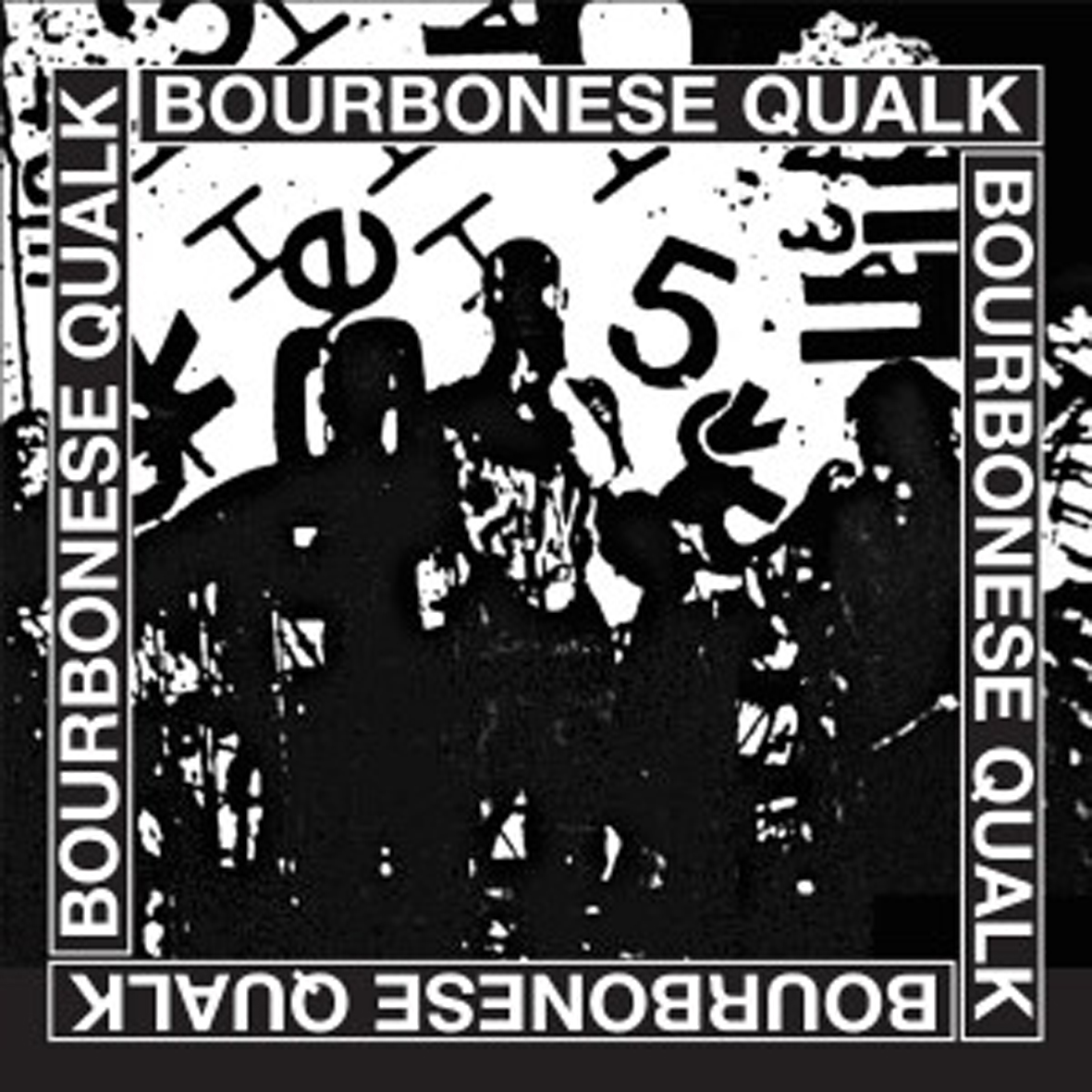Bourbonese Qualk, "Bourbonese Qualk 1983-1987"
 On paper, this compilation seems like exactly what the world needs: a new compilation celebrating the legacy of a criminally underappreciated and mostly forgotten band whose entire catalog is largely out-of-print.  In reality, however, Bourbonese Qualk 1983-1987 is kind of a perplexing mixed success, as Mannequin decided to focus exclusively on Qualk's rather primitive early years, bypassing almost all of their more distinctive and original work.  There is still a lot to like here, as the band originally sounded kind of like an anarcho-punk band that could not afford guitars or a full drum kit, but this era definitely would not have been my first choice if I were commencing my own reissue campaign.
On paper, this compilation seems like exactly what the world needs: a new compilation celebrating the legacy of a criminally underappreciated and mostly forgotten band whose entire catalog is largely out-of-print.  In reality, however, Bourbonese Qualk 1983-1987 is kind of a perplexing mixed success, as Mannequin decided to focus exclusively on Qualk's rather primitive early years, bypassing almost all of their more distinctive and original work.  There is still a lot to like here, as the band originally sounded kind of like an anarcho-punk band that could not afford guitars or a full drum kit, but this era definitely would not have been my first choice if I were commencing my own reissue campaign.
This compilation is essentially a "greatest hits" overview of the first five Bourbonese Qualk albums, which I suppose offers significant utilitarian value for anyone delving into their somewhat extensive catalog.  Granted, all five albums are available in their entirety for free at the Bourbonese Qualk website, but I can see the appeal of having their highlights condensed into a single attractive-looking package (especially since I vastly prefer Qualk's later work).  There is some internal logic to focusing on this particular period as well, as it covers both the band’s full run as a trio of Simon Crab, Julian Gilbert, and Steven Tanza and their entire stretch of self-released albums (with the exception of 1990's Bo’Qu compilation).
The four pieces collected from 1983's Laughing Afternoon generally capture the group at their most straightforward, primarily consisting of little more than leaden beats, processed unmelodic vocals, and repeating bass lines.  There are certainly some glimmers of the band's more ambitious future in the unusual beat, odd squawks, and tape experimentation in "God With Us," but the core aesthetic at this point is basically just processed shouting over a simple beat.  The only real exception is the brief dub experiment of "Qualk Street," which features some surprisingly melodic guitar work from Crab as well as some unexpectedly fluid drumming from Tanza.
Hope’s five contributions offer quite a bit more promise, though a couple of pieces are just retreads of the previous "thumping-and-shouting" formula with some slap bass thrown into the mix (which definitely does not help matters).  The throbbing, trance-like "Invocation" is very adventurous by 1984 standards though, augmenting its relentless forward movement with shifting percussion flourishes and buried, Eastern-tinged burblings.  Hope also seems to be the point where Qualk started to get weird and hard-to-define in earnest, as the trio also veer into pulsing, straight-forward industrial dance ("Head Stop") as well as something that sounds like a skilled ethnographic forgery ("Black Madonna") until the unfortunate vocals appear to ruin the spell.
1985’s Spike is even more of an oddity, as it was originally released on a German label rather than the trio's own Recloose Organisation or New International Recordings imprints.  Also, half of the album was devoted to the soundtrack for a dance performance, represented here by the fluidly rumbling and ritualistic instrumental "Deadbeat." The rest of the album seems like it was a bit of an informal grab-bag though, culled from recordings the band made while organizing the Atonal festival in Berlin.  For example, "Shutdown" initially starts off with some promising tape-loop work, but quickly becomes another plodding exercise in shouting and "funky" bass playing.  The remaining "Suburb City" and "Pogrom" mark major leaps forward, however, incorporating Crab's Middle Eastern-sounding violin playing into a pair of inventive and enjoyable grooves.
Gilbert and his vocals appear to have been largely absent from 1986’s significantly improved Preparing For Power, though he contributes a passable (if unintentional) John Balance impression in the excellent "Return to Order," which features the band’s most effortlessly melodic and nuanced music to date (it sounds like a reggae Coil, actually).  The other six pieces culled from Power are not quite as immediately gratifying, but a few of them are quite good and tower above almost everything from the preceding albums.  "Outcry," for example, sounds like a soulful collision between jazz and Cocteau Twins, while "Soft City" resembles a mariachi band jamming with a drum machine.  Other pieces, however, sound either like a poor man’s Crass or simply abstract experiments that have not aged particularly well.
Gilbert was officially gone for 1987’s self-titled album, which also proved to be Tanza’s swan song as well.  Curiously, Bourbonese Qualk is only represented by two pieces, but they are both quite strong.  "This is the Enemy" again recalls Coil to some degree, but mostly because it feels like an ingeniously warped fever dream of a song. The closing "Work Over," on the other hand, captures Crab and Tanza at absolute their peak as a rhythm section, locking into a heavy, propulsive, and multi-layered groove beneath some beautifully weird and garbled robotic vocals.
Ultimately, Bourbonese Qualk 1983-1987 is exactly what its title promises, which I suppose makes it a success, albeit one for a somewhat enigmatic audience: I cannot think of anyone who would need this, aside from longtime fans who just want a physical product.  I suppose this also provides a handy overview for the curious, but the curious would be much better served by checking out later releases like On Uncertainty or Unpop long before this, as most of these songs are too rudimentary and dated to offer a big return entertainment-wise in 2015 (except for those with an unhealthy obsession with early '80s industrial music).  That said, I certainly cannot fault Mannequin for wanting to tell the world about Bourbonese Qualk.  Also, the chronological order of the pieces provides a fitfully compelling and informative overview of the formative years of a very idiosyncratic entity.  This may not represent Qualk's best work, but it at least does an excellent job showing how they eventually got there (warts and all).
Samples:
 



